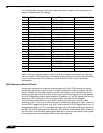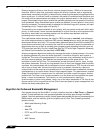
Firewall Settings > QoS Mapping
763
SonicOS 5.8.1 Administrator Guide
The first Access Rule (governing LAN>VPN) would have the following effects:
• VoIP traffic (as defined by the Service Group) from LAN Primary Subnet destined to be
sent across the VPN to Main Site Subnets would be evaluated for both DSCP and 802.1p
tags.
–
The combination of setting both DSCP and 802.1p marking actions to Map is described
in the table earlier in the “Managing QoS Marking” section on page 760.
–
Sent traffic containing only an 802.1p tag (e.g. CoS = 6) would have the VPN-bound
inner (payload) packet DSCP tagged with a value of 48. The outer (ESP) packet would
also be tagged with a value of 48.
–
Assuming returned traffic has been DSCP tagged (CoS = 48) by the SonicWALL at the
Main Site, the return traffic will be 802.1p tagged with CoS = 6 on egress.
–
Sent traffic containing only a DSCP tag (e.g. CoS = 48) would have the DSCP value
preserved on both inner and outer packets.
–
Assuming returned traffic has been DSCP tagged (CoS = 48) by the SonicWALL at the
Main Site, the return traffic will be 802.1p tagged with CoS = 6 on egress.
–
Sent traffic containing only both an 802.1p tag (e.g. CoS = 6) and a DSCP tag (e.g. CoS
= 63) would give precedence to the 802.1p tag, and would be mapped accordingly. The
VPN-bound inner (payload) packet DSCP tagged with a value of 48. The outer (ESP)
packet would also be tagged with a value of 48.
Assuming returned traffic has been DSCP tagged (CoS = 48)
by the SonicWALL at the Main
Site, the return traffic will be 802.1p tagged with CoS = 6 on egress.
Destination Main Site Subnets Lan Primary Subnet
Users Allowed All All
Schedule Always on Always on
Enable Logging Enabled Enabled
Allow Fragmented Packets Enabled Enabled
Qos Tab
DSCP Marking Action Map Map
Allow 802.1p Marking to
override DSCP values
Enabled Enabled
802.1p Marking Action Map Map
Setting Access Rule 1 Access Rule 2


















